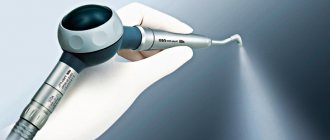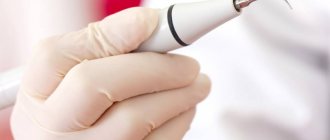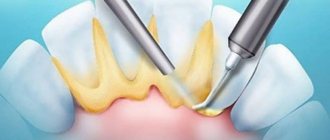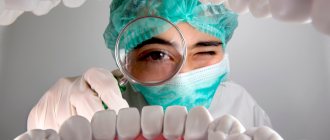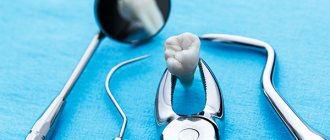Even high-quality oral care does not eliminate the possibility of injury or another factor that may require tooth extraction. The need to tear it out with forceps or saw it into pieces with a milling cutter for fragmentary removal causes unpleasant associations and becomes a reason to delay a trip to the dentist.
An innovation in 2017-2018 was the use of ultrasonic equipment in dentistry - a piezotome - for tooth extraction. Previously, ultrasound was used to remove tartar and treat periodontal disease.
Author of the article: Omerelli Emir Romanovich
Work experience:
13 years
Specialization:
maxillofacial surgeon-implantologist and candidate of medical sciences
Works:
at the clinic on Proletarskaya metro station
Why we use PiezoSurgery®
We eliminate any risks when removing teeth, because... surgical treatment in our Center is carried out in the LifeTime Warranty format, a lifetime guarantee
| Classic method | Ultrasound removal |
| Burn When segmenting a tooth with a drill, friction is created, the tooth tissue heats up and provokes a burn of the mucous and bone tissue | Burn Ultrasound does not heat the surface, the cut is formed without the instrument touching the tooth |
| Soft tissues The more difficult the removal, the more difficult it is not to injure the mucous membrane around the tooth with an elevator, forceps, drill, saw or chisel | Soft tissues The piezo scalpel does not affect soft tissues, which greatly reduces pain during and after surgery, as well as bleeding |
| Bone tissue Preserving bone for subsequent implantation is quite difficult; the volume of bone material for subsequent regeneration will require a significant amount | Bone tissue The bone remains unharmed - immediate implantation is possible on the day of removal or delayed with minimal replanting of bone material |
| Safety Wound surface increases the risk of secondary infection | Safety The invasiveness of the mucous membrane is reduced to zero, plus ultrasound has a disinfecting effect |
| After surgery Injury to soft tissues, especially with multiple removals, provokes pain in the postoperative period | After surgery Ultrasonic removal is a minimally invasive operation, pain is either completely excluded or insignificant |
| Cost Low cost for classic removal in a clinic “around the corner” does not guarantee safety and comfort | The cost of Piezosurgery in a decent clinic is not assessed separately, because... is an integral part of safe treatment |
Advantages and disadvantages
Let's consider several factors due to which piezosurgery is popular among patients and dentists:
- Rapid tissue healing.
- Reducing the risk of inflammation and infection after surgery.
- Painless and no discomfort.
- The procedure is low-traumatic, so no blood is observed during treatment.
- Unlike classic unit removal, piezosurgery is performed 10-15 minutes faster.
- Easy access to remote areas of the oral cavity.
The only disadvantage we can note is the cost, which is twice the price of a standard procedure without the use of ultrasound.
Ultrasound tooth extraction Advantages of performing surgery in your sleep
Sedation in dental surgery is the “gold standard” for surgical operations in dental clinics in Europe and the USA.
- Absolute comfort for the patient: no stress, pain, medical odors and unpleasant memories
- Combined anesthesia without injections into the gums
- For patients with heart disease, this is the only opportunity to receive dental care
More about sedation
The combination of sedation and piezosurgery ensures 100% safety and comfort when removing even the most complex teeth in unusual cases.
Removal technology
Stages of the procedure using the example of an incompletely erupted wisdom tooth:
- Diagnosis of contraindications.
- The patient is given local anesthesia.
- An ultrasonic “scalpel” is used to peel off the gum tissue to free the surgical field.
- The tooth is carefully defragmented using ultrasound (without pain, pressure or touching the equipment to the tissue).
- The tooth elements are easily removed from the socket along with the roots.
- The mucous membrane is returned to its place, and stitches are applied if necessary.
How does ultrasonic removal work “in your sleep”?
Ultrasound removal is performed using special piezosurgical devices. The main feature is that the device affects only hard tissues and turns off when it touches soft ones, such as gums, nerves and blood vessels.
Sequencing:
- A butterfly catheter is fixed on the patient’s wrist (we use the most delicate ones from a children’s set) and an infusion pump is connected for controlled administration of drugs.
- If necessary, the assistant administers local anesthesia to be 100% sure that the treatment is painless; by this time the patient no longer feels the injection.
- The doctor checks sensitivity to pain and the removal operation begins. While the surgeon works, the anesthesiologist monitors the patient's condition, checks breathing, pulse and measures blood pressure on cardiac monitors.
- An ECG is performed directly during the treatment process; control of the balance of oxygen and carbon dioxide is automated by our own oxygen generation station.
- The work ends, the anesthesiologist awakens the patient, and the assistant takes him to a control x-ray to check the correctness of the operation.
- 30-40 minutes after removal and the anesthesiologist checking the patient’s condition, you can go home.
Ultrasound tooth extraction is an ordinary routine event for our surgeons. At the Doctor Levin center, the most complex maxillofacial and ENT operations using piezosurgery are performed daily: sinus lifting, maxillotomy, multiple tooth extractions. For an average surgeon, the remaining teeth before implantation are a hindrance and do not stand on ceremony with them. The result is broken bone structures of the jaw, wandering remnants of roots, unremoved cysts growing into the maxillary sinus, perforations, fistulas, osteomyelitis and much more. Not to mention the shocking post-operative pain that overtakes the patient after such punitive surgery. Entrust removal to an oral and maxillofacial surgeon. Only the maxillofacial surgeon has enough theoretical and practical skills to perform tooth extraction without complications.
My life's goal is to create the best oral and maxillofacial clinic in the world.
High-quality surgical care without complications and with absolute comfort - in your sleep, without stress, pain and unpleasant memories
Levin Dmitry Valerievich Chief physician and founder of the Doctor Levin center
Indications and contraindications
Ultrasonic tooth extraction can be used in all cases where extraction is necessary. The location and type of tooth does not matter. At the same time, there are a number of indications when a doctor can strongly recommend the use of ultrasound to ensure a predictable result and minimize possible complications:
- the patient has a bleeding disorder;
- abnormal position of teeth;
- complex tooth extraction that is covered with soft tissue growths;
- after an unsuccessful classical removal procedure;
- wisdom tooth removal;
- removal of impacted and dystopic teeth (in particular, eights with pathology);
- tooth extraction and immediate implantation;
- tooth extraction during pregnancy;
- tooth extraction for children, especially those with severe dental phobia.
The procedure also has a number of contraindications, in the presence of which the use of ultrasound is not recommended or strictly prohibited:
- For patients with a pacemaker, ultrasound is completely contraindicated;
- milk and mixed dentition in children (not recommended);
- HIV, hepatitis, tuberculosis;
- bronchial asthma;
- disorders of the central nervous system, mental disorders;
- extensive demineralization of enamel.
The reception is being conducted
Nazaryan Aram Samvelovich
Dentist
Head of the Dental Department. General dentist
Sadoeva Irina Aslanovna
Dentist
Dentist
Konyaeva Elena Vladimirovna
Pediatric dentist, Dentist-therapist
Pediatric dentist, dental therapist
If you are concerned about one or more symptoms, you should not hesitate to visit a doctor, since failure to contact a specialist in a timely manner can lead to irreversible processes.
7
Contraindications for removal
Contraindications to ultrasonic tooth extraction are the presence of the following deviations:
- Having severe heart disease. An absolute contraindication is an installed pacemaker.
- Neurological abnormalities.
- Bronchopulmonary diseases, including bronchial asthma.
- HIV, viral hepatitis, tuberculosis, herpes.
- The period of change of milk teeth.
- Weak immunity.
- Oncological disease.
- Diabetes.
Features of the postoperative period
Unlike classic removal, a wound in the oral cavity heals very quickly. Doctors recommend following these rules after surgery:
- When you get home, take a piece of ice and wrap it in a clean cloth. Apply the compress to the cheek on the side where the unit was torn out. Instead of ice, you can use frozen foods.
- Try not to stick your tongue into the damaged socket. This may disrupt the clot formation process, resulting in a longer healing period.
- If pain is observed after the anesthesia wears off, you are allowed to take a painkiller.
- If necessary, a specialist may prescribe antibiotics.
- Rinse the mouth cavity only as prescribed by the dentist.
- Avoid saunas, hot baths, and heavy lifting for at least 5 days.
Ultrasound is used in private dental clinics. If you are interested in this service, when making an appointment with a doctor, check whether the clinic provides such a service.
Why should wisdom teeth be removed?
The growth of wisdom teeth is accompanied by many problems. In addition to discomfort and pain, the usual parameters of the jaw change. To facilitate cutting, domestic dentists perform operations on the gums and apply subsequent treatment using pharmaceuticals.
Foreign specialists (USA, EU, Israel) prefer wisdom tooth removal in 99% of cases. The only exception is the patient's individual contraindications.
The stated statements are based on the results of large-scale studies. A thorough study of real problems in several hundred thousand people revealed the following typical complications with wisdom teeth:
- frequent cheek biting with the appearance of bleeding wounds and infections;
- reduction of the distance between other teeth with the simultaneous development of periodontal disease and other dental diseases;
- provoking sore throats, pharyngitis, and other inflammatory processes;
- visible curvature of the frontal line of the teeth;
- difficulty performing routine oral hygiene procedures;
- incomplete removal of food residues with the formation of unpleasant odors.
It should be emphasized that the wisdom tooth is relatively less durable. It degrades quite quickly, so subsequent removal will still be necessary. The appearance of internal cracks and other structural disturbances complicate the operation. The use of the classical technique injures adjacent tissues and tooth enamel. Healing takes a long time. Ultrasonic technology does not have such disadvantages.
What to do if a wisdom tooth grows horizontally
The above facts convincingly indicate not only the need for timely removal of wisdom teeth. You need the right choice of surgeon. Only a true professional with extensive experience can perform a high-quality wisdom tooth extraction. But we must remember that the old methods, by their principles, are characterized by a fairly high level of injury.
Advantages of visiting the Trilogy clinic
The reliable Trilogy clinic specializes in providing various services in the field of dentistry in Moscow. We employ leading orthopedic doctors, orthodontists, periodontists, therapists and surgeons who regularly improve their skills by participating in scientific exhibitions and conferences. Thanks to extensive experience and equipping the clinic with modern equipment, they are ready to cope with clinical cases of any severity.
Numerous positive reviews from patients confirm the high quality of the services provided. At the same time, prices for services are affordable (you can find out more about the price list on the website). To make an initial appointment with a medical and dental specialist, simply fill out a standard form on the website, indicating contact information - name and phone number.
What is piezosurgery
The piezoelectric effect is the physical principle that causes quartz crystals to vibrate when an electrical current is applied. Thanks to special mechanisms for transmitting vibration generated by quartz and converted into oscillatory movements of the insert, which allows selective removal of tissue. This procedure has proven effective in various areas of surgery.
The main advantage of piezosurgery is that soft tissues that come into contact with the vibrating material are not damaged. This reduces the risk of injury to vital nerves or blood vessels.
An important property that further confirms the advantages of using piezoelectric equipment is the ability to deflect the vibration of the drug through the instrument. The achieved preparation of less hard and soft tissue allows for smaller approaches and reduces morbidity in patients undergoing apicoectomy.
Procedure algorithm
With the help of piezosurgery (intervention with an ultrasonic device), it is possible to effectively work in hard-to-reach places in the oral cavity, perform bone grafting on the upper and lower jaw, and remove molars without causing injury to the surrounding bone. At the initial consultation, the specialist will examine the oral cavity and determine the degree of damage. If necessary, an examination will be prescribed to identify absolute and relative contraindications.
The principle of ultrasonic removal is based on the use of a special system, which includes a tip, nozzles and a physiodispenser for supplying the solution. There is a pedal with which the doctor can independently regulate the speed of the handpiece. The supplied solution cools and disinfects the affected area.
The tip generates ultrasonic vibrations that are applied to the nozzle. These vibrations cut through hard tissue (in particular, tooth and bone). It is worth noting that soft tissues and mucous membranes are not injured during the procedure. Blood loss during the procedure is minimal. The tip acts quickly and as accurately as possible, tooth tissue is removed with extreme caution. In this case, there is no close contact with the tissues; manipulations are carried out at a small distance from the molar.
The dispenser delivers sterile saline solution to the tip. Due to the lack of direct contact with mucous membranes and the provision of an antibacterial effect, saline solution has a therapeutic effect on the hole and tissues. This ensures faster healing. After the surgery is completed, the doctor may prescribe antibiotic therapy.
